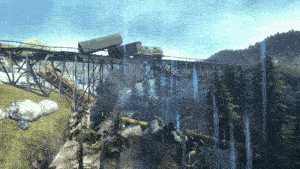Baked physics
December 2025

(Click to view if GIF does not play automatically).
Baked physics, sometimes referred to as "cinematic physics", are baked animations created in an offline animation package that are not simulated in real-time, typically portraying large destruction events then played back in-game. Valve used Blast Code to create complex physics simulations in Source 1 games, most of which were done by Gray Horsfield. Blast Code is no longer available, however, there are alternatives.
In Condition Zero Deleted Scenes and Half-Life 2: Episode Two, baked physics are often played back in game at specific events, often for narrative purposes. In Source, baked physics animations typically get streamed in from ANI animation files, which fragment the animation data so it can get loaded on-demand in game.
When creating cinematic physics, it is important to keep the limitations of the target game engine in mind, such as limitation of object count per model, which may require using multiple models for a single effect. In Source, it is recommended to create the model in 3 states : pre-destruction, the actual destruction animation, and a post-destruction model that Source can show after the animation has finished.
Baked physics are used in
hybridphysx, inside models, contains baked physics (.ani) which are presumably seems to be created using Nvidia PhysX.See also
External links
- Cinematic Physics in 3DS Max - Legacy Interlopers.net Tutorial for 3DS Max
- RayFire Simulation System - Destruction system for 3DS Max
- SideFX Houdini - Procedural 3D Toolkit including simulation tools
- Blender - Includes primitive simulation tools
- Blender Fracture Modifier - Blender 2.7 build with destruction tools
- GoldSrc baked physics tutorial by The303